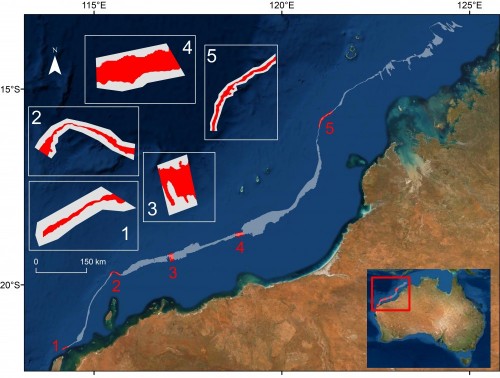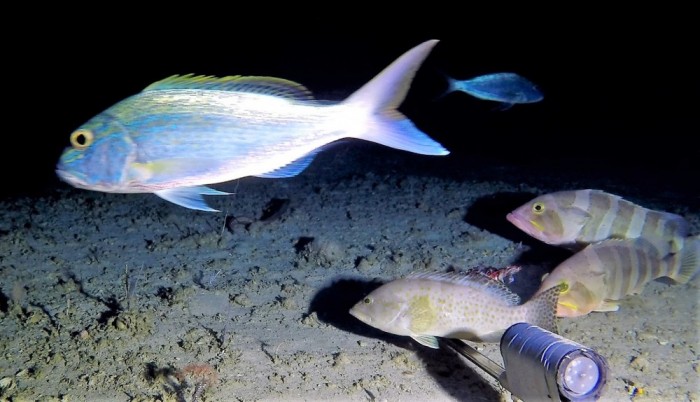Finding fish on the Ancient Coastline KEF (125 m) with underwater video
AIMS acknowledges the Yinggarda, Baiyungu, Thalanyji, Yaburara, Mardudhunera, Ngarluma/Yindjibarndi, Ngarla, Bindunbur and Bardi Jawi People, as Traditional Owners of the country adjacent to the Ancient Coastline where this Northwest Shores to Shoals work was undertaken. We recognise these People’s ongoing spiritual connection to country and pay our respects to their Aboriginal Elders past, present and emerging.
Key Ecological Features (KEFs) are parts of the marine ecosystem considered to be of particular importance for either a region's biodiversity or its ecosystem function and integrity (see them all). This could relate to a species integral to a community (e.g. a predator that impacts a large biomass or number of species), an important habitat type (e.g. that supports high productivity or aggregations of nesting or breeding animals), or a unique seafloor feature that positively impacts the surrounding ecosystem (e.g. a deep canyon that stimulates upwellings of nutrient rich water).
13 KEFs have been defined for Australia’s North-west Marine Region, including the ‘Ancient Coastline at 125m depth contour’ (AC125). The AC125 is thought to “provide areas of hard substrate and therefore may provide sites for higher diversity and enhanced species richness relative to surrounding areas of predominantly soft sediment.” The North West Shoals to Shore Research Program investigated seabed habitats and their biodiversity to inform management and sustainable development of the region (read the full paper here).
Little is known about what fish species call the AC125 home. Part of the reason is that the AC125 is very deep, and thus difficult to observe. To fill this gap, we conducted fish relative abundance and diversity surveys across five study Areas of the AC125 using Baited Remote Underwater Video Stations (BRUVS). BRUVS were deployed on and off the AC125 at a minimum distance of 500 m between each unit. A total of 204 BRUVS deployments were conducted at depths between 62.1 m and 181.4 m across each study Area from the RV Solander.

We found the highest number of fish species (richness - see our predictive maps of richness here) in Area 1, where depth and habitat type varied the most. Small pockets of complex seabed topography (outcrops and edges) that support an abundance of bottom-dwelling organisms (eg, gorgonians, sponges), were found in Areas 1, 5 and 3, particularly in shallower depths. These sites supported the most diverse fish communities including emperors (Serranidae), cods and snappers (Lutjanidae) and a range of other species.

The commercially important gold band snapper (Pristipomoides multidens) was frequently encountered across AC125 habitats, with a preference for more complex habitats but also frequently ranging into the sand and rubble habitats common in Area 5. Fish diversity was lower in the vast open silty (particularly Area 3) and sandy seabed areas. Fish in these areas included small threadfin breams (Family Nemipteridae), pufferfishes (Lagocephalus spp.) and wide-ranging large predators like sandbar sharks (Carcharhinus plumbeus) and hammerhead sharks (Sphyrna spp.).

We also observed species that are IUCN Red listed, such as the bignose shark (Carcharhinus altimus, listed as 'data deficient'), and the wedgefish (Rhynchobatus australiae), which is listed as ‘critically endangered’. We found the latter in deeper water than ever seen before in Australia.
The interactive maps below display the point locations where BRUVS were collected for the study. Click on the blue dots to learn more about where and when the BRUVS was deployed. Click on the red dots to also see a video of marine life found to exist there.
Legend
KEF Area 1
KEF Area 2
KEF Area 3
KEF Area 4
KEF Area 5
See the metadata - Read the full paper
AIMS’ North West Shoals to Shore Research Program is proudly supported by Santos as part of the company’s commitment to better understand Western Australia’s marine environment.




